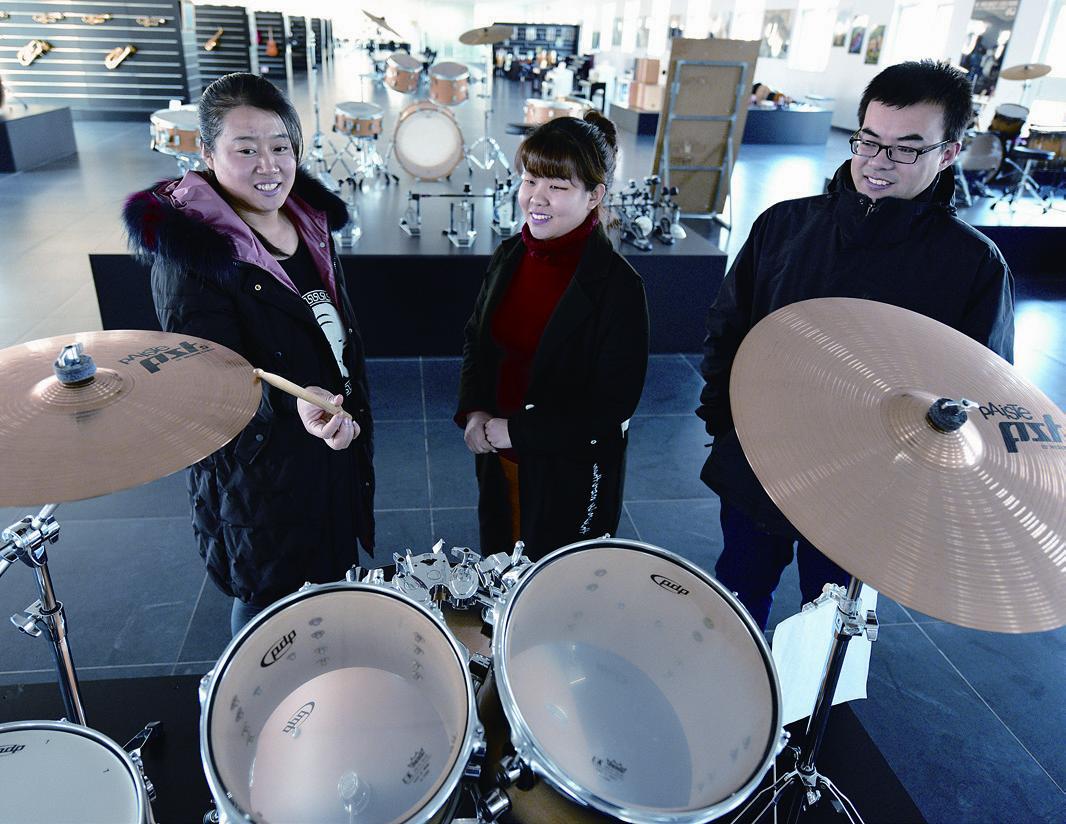Green Fashion

Green Fashion
Children at a local kindergarten take part in an eco-fashion show during an environmental awareness activity in Huzhou, east Chinas Zhejiang Province, on December 12.
Poverty Reduction
The poverty rate has dropped substantially in the past 40 years, especially in rural areas, thanks to reform and opening up, Liu Yongfu, Director of the State Council Leading Group Offi ce of Poverty Alleviation and Development, said on December 8.
The proportion of people living below the national poverty line decreased among the rural population from 97.5 percent in 1978 to 3.1 percent at the end of 2017.
More than 700 million rural residents have been lifted out of poverty over the past 40 years. It marks a miracle in th e history of poverty reduction, Liu said, calling reform and opening up the driv- ing force behind the success. The targeted poverty reduction strategy, adopted six years ago, is the correct choice in the new era, he added.
The battle against poverty is one of the “three tough battles” China needs to win to build a moderately prosperous society in all respects by 2020. To achieve the goal, around 30 million rural residents have to be lifted out of poverty by 2020.
Endemic Diseases
A three-year campaign has been launched to prevent and cure endemic diseases between 2018 and 2020, according to an action plan released by the National Health Commission and nine other authorities.
By the end of 2020, the target is to eradicate iodine defi ciency and end fl uorine and arsenic poisoning caused by coal burning. It also includes ending Kaschin-Beck disease, a bone joint disorder, and Keshan disease, a heart problem caused by mineral defi ciency.
The plan will seek to control poisoning caused by fl uorine and arsenic-laden drinking water, endemic fl uorine poisoning caused by tea drinking and water-borne iodine excess.
Schistosomiasis or worm infection will also be eliminated.
The campaign has aligned its target with the national goal to eradicate absolute poverty by 2020 and requires that all current endemic disease patients and advanced-stage schistosomiasis patients receive ef- fective treatment.
Measures such as improving nourishment and housing conditions, as well as relocating people from disease-causing environments, will be taken to meet the goal.
The action plan includes a timetable for the prevention and cure of endemic diseases. Comprehensive measures will be jointly fi nanced by central and local authorities.
Progress in the control of endemic diseases will be an important index in assessing the work of local governments.
As of 2018, 94.2 percent of Chinas counties shook off iodine defi ciency. Keshan disease is under control in over 94 percent of the counties where it was prevalent, while 95.4 percent of the counties once suffering from Kaschin-Beck disease are now free from it.
National Identity
Young Chinese have a stronger sense of national identity and are more confi dent of the countrys development than previously, according to a survey by China Youth Daily and the offi cial microblog of the Communist Youth League of China Central Committee published on December 11.
Of over 6,000 respondents, 92.9 percent thought the country has developed since its reform and opening up in 1978. This is 3 percentage points higher than the fi gure from a similar survey conducted by the newspaper 20 years ago.
Also, 96.1 percent felt proud of Chinas achievements, while 93.5 percent said given a chance to choose their homeland, they would choose China.
More than 73.4 percent of the participants were born between 1990 and 2000.
Water Conservation
China has made headway in pushing major water conservancy projects to enhance fl ood control and drought relief capacity, as well as food and ecological security, Wang Annan,an offi cial with the Ministry of Water Resources, said.
Some 130 water conservancy projects have been under construction since 2014, with investment exceeding 1 trillion yuan ($146 billion). These projects are promoting coordinated development among regions and poverty alleviation work, as 75 percent of them are located in central and western regions and 56 percent in poverty-stricken areas, Wang said.
They are part of the national plan announced in 2014 to step up the construction of 172 key water conservancy projects by 2020.
By the end of 2019, over 80 percent of the 172 projects will be under construction. The biggest investment in 2019 will go to the water allocation project in the Pearl River Delta region in south China.
Redefined Kilogram
China will adopt the new definition of the kilogram on May 20, 2019, embracing a weighty change in the international system of units for the development of next-level measurement.
“The redefi nition will enable physics, chemistry and biology to gauge at the extreme level and revolutionize the industry of instruments and meters,” Xie Jun, an offi cial with the State Administration for Market Regulation, told a news conference on December 11.
Though the change will not have a visible impact on peoples daily lives, it is a game-changer for things like nuclear reactors, spacecraft and biological medicine, Xie said.
The move follows a decision by multinational scientists to do away with the old kilogram prototype and determine the unit with a constant of quantum physics starting on the next World Metrology Day on May 20, 2019.
Since 1889, scientists have based their defi nition of the fundamental unit of mass on a physical object—a shining platinum-iridium cylinder and its replicas. A kilogram is equal to the heft of such an aging piece of metal, and discrepancies of as much as 50 micrograms have been found in some replicas.
In November, members of the International Bureau of Weights and Measures from more than 60 countries and regions gathered in France and decided to update the defi nition to the Planck constant, a fundamental constant of quantum physics that is reliable across time and space.
China now ranks third in terms of calibration and measurement prowess in the world, Xie said, adding that the country has built a device to reproduce the newly-defi ned kilogram.
Competition of Creativity
Contestants refi ne their works during the sixth Undergraduate Snow Sculpture Competition of Heilongjiang Province at the Sun Island International Snow Sculpture Art Expo park in Harbin, capital of the northeastern province, on December 12.
Rural Tourism
The Ministry of Culture and Tourism, the National Development and Reform Commission and 15 other departments have released a guideline with fi ve major measures for the sustainable development of rural tourism. They include strengthening planning for coordinated regional development, improving infrastructure and public services, enhancing the quality of products and the level of service and management, innovating the marketing mode, and boosting poverty alleviation.
The guideline also suggests supporting measures to improve the fi nancial investment mechanism and guarantees for land use for rural tourism.
According to Ning Zhizhong, chief designer of the Tourism Research Center of the Chinese Academy of Sciences, around 70 percent of tourism resources are in rural areas, indicating that the potential for rural tourism is huge. The inclusion of rural tourism in regional social and economic development is signifi cant for the prosperity of rural industries.
The guideline will help create a win-win situation where villagers are better off, investors get due returns and the rural environment improves, Wu Liyun, an associate researcher at the China Tourism Academy, said.
A Riot of Colors
A visitor takes photos of a fabric artwork during the fourth Shanghai International Hobbycraft Expo on December 7. More than 300 Chinese and overseas exhibitors took part in the three-day fair.
Improving P rofitability
A majority of Chinese listed fi rms expect to see improved profi tability in 2018 as the countrys economy maintains stable development.
Some 1,218 listed companies have released their advance 2018 fi nancial reports, with 781 companies expecting increased net profi ts or reversing losses, Shanghai Securities News reported on December 11.
A total of 344 companies are expected to exceed 50-percent profi t growth, while 170 companies predict their 2018 net profi ts will be more than double when compared with 2017.
Chemical, machinery manufacturing and electronics sectors were especially positive according to the reports.
Rising prices boosted the profi tability of the chemical industry, with 91 companies expecting growth.
This is followed by 71 companies in machinery manufacturing and 68 companies in electronics.
Catching Up
Semi-premium Chinese SUV brands are catching up with their foreign rivals as technology improves and they cater better to consumersneeds, according to the latest industry report released by brand valuation consultancy Brand Finance.
In its report titled Chinese Automobiles 2018, the consultancy said that although most Chinese brands are still in the middle to lowend market, some Chinese brands such as WEY and Lynk & Co are targeting a slightly higher-income demographic by using improved technology and more differentiated, premium marketing.
Despite only being active for two years, WEY already commands 7 percent of the market for 150,000-200,000-yuan ($21,741-$28,988) cars—a market which constitutes 1.4 million units sold in China each year. Lynk & Co sold more than 4 percent of vehicles in the same bracket, said the report.
It also highlighted prejudice against Chinese brands is waning with WEY considered more “stylish”and “cool” than Land Rover by a new generation of consumers.
Brand value of the top fi ve Chinese brands has risen 92 percent from 2017 to 2018, thanks largely to local demand. In comparison, the value of brands from other countries has risen only 9 percent, according to the report.
Hi-Tech Farming
A staff member adjusts the volume of fertilizers for vegetables in a greenhouse through an all-in-one machine for watering, power supply and fertilizing in Haimen, east Chinas Jiangsu Province, on December 4. Eco-friendly, higheffi ciency agriculture has become a new engine for the local growth.
Tech and Innovation
Zhejiang Province, Chinas private business hub, has pledged tens of billions of dollars to drive tech and innovation over the next fi ve years, local authorities said on December 10.
The province announced a total of 50 measures to boost hi-tech and Internet companies as well as to foster medical research and development (R&D;). Over the coming fi ve years, the provincial, municipal and county-level governments in Zhejiang will spend a total of 120 billion yuan ($17.3 billion) to achieve the goal, according to Gao Yingzhong, head of the provincial Science and Technology Department.
“We will also guide social capital and fi nancial institutions to invest 290 billion yuan ($42.4 billion),” said Gao. “The total investment for R&D; is expected to reach around 900 billion yuan ($130.9 billion).”
The measures also include increasing the ratio of R&D; expenditures in provincial GDP, cultivating leading innovators, and increasing patent numbers.
IPR Protection
China has been improving the legal protection of intellectual property rights (IPR), according to statements at a press conference by the State Council Information Offi ce on December 11.
The press conference, focusing on “reform and opening up and IPR development,” detailed Chinas achievements in IPR protection.
China has built a sound legal system in IPR protection, with laws including those regarding trademarks, patents, copyrights and competition enacted and enforced.
China has experienced huge changes in pushing forward legal protection over the last 20 years, said Wu Handong, a former professor of economics and law at Zhongnan University.
More patent lawsuits among overseas companies were conducted in China. This is a signal of confi dence in Chinas judicial judgment and preference for the Chinese market, said Yang Wu, head of the All-China Patent Attorneys Association.
China began to accept patent applications in 1985 and in 2017, the country had 1.38 million invention patent applications, leading the world for the seventh consecutive year.
Friendly Neighbors
A worker monitors digital printing facilities in Guan County, north Chinas Hebei Province, on November 30. In recent years, the county has pursued innovation-oriented development by taking full advantage of its proximity to Beijing and Tianjin, accelerating the development of hi-tech industrial systems and ensuring rapid growth of the local economy.
Planning for the Future
Ethylene glycol (EG) futures were formally launched on December 10 at the Dalian Commodity Exchange, to help domestic enterprises improve price risk management.
On the fi rst trading day, the market edged down, with total transaction volumes amounting to 40.15 billion yuan ($5.94 billion), involving six products with different delivery months.
An important raw material in the petrochemical industry, EG is widely used in polyester fi ber manufacturing, with end products ranging from clothing to carpets.
The price of EG has fl uctuated drastically in recent years and has had a signifi cant impact on relevant industries, according to Chang Depeng, spokesperson with the China Securities Regulatory Commission. The listing of EG futures will provide a better hedging tool for companies and facilitate a healthy industry chain, he said.
Currently, China is the largest EG importer and consumer in the world. In 2017, China produced 5.57 million tons of EG—20 percent of the worlds total.
Largest Cruise Market
China is likely to become the worlds largest cruise market in the next 10 to 20 years as its travel industry and the public sector step up moves to boost marine-based tourism, China Daily reported on December 10.
According to the Cruise Lines International Association, by 2025, the number of Chinese tourists who have taken a cruise is expected to reach 8 million to 10 million, up from 2.5 million last year.
Measures are being taken to modernize and upgrade ports, purchase ocean liners, develop multimodal transport mechanisms and approve longer-duration visa-free visits to certain Chinese mainland areas in the neighborhood of ports, according to the report.
Shanghai plans to build an integrated complex complete with dutyfree shops comparable to those at an international airport. Efforts are also underway to introduce links between cruises, airlines, trains and buses.
The southernmost island province of Hainan has started a pilot run of its 15-day visa-free policy for tourists.
Musical County A saleswoman at a musical instrument company in Wuqiang County, north Chinas Hebei Province, introduces jazz drums to customers on December 8. The county has strengthened its support for musical instrument enterprises by encouraging innovation, promoting academia-industry partnerships and offering training courses for entrepreneurs.

